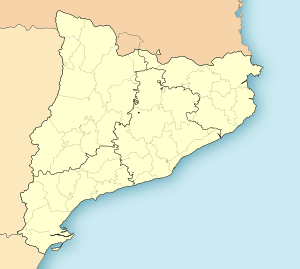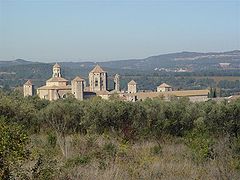Ruta del Cister
| |
The monasteries of Poblet , Santes Creus and Vallbona on the Ruta del Cister
|
The Ruta del Cister ( Catalan , "Route of the Cistercians") is a tourist region in the triangle of the cities of Barcelona , Tarragona and Lleida in Catalonia . It is characterized by the country's three large Cistercian monasteries from the 12th century: Santes Creus , Vallbona de les Monges and Santa Maria de Poblet . A long-distance hiking trail connects the three monasteries.
Royal monasteries
The area occupied by the Moors in the 8th century was recaptured by the Counts of Barcelona in the 10th century and the region, which had been almost depopulated for several centuries, was subsequently settled by people from the county of Barcelona . In the first half of the 12th century, under Count Ramon Berenguer IV, the three monasteries were built almost simultaneously as a sign of triumph and stone thanksgiving for the expulsion of the Muslim Arabs. Until the end of the Catalan-Aragonese kingdom , the monasteries remained royal tombs.
Poblet
Santa Maria de Poblet was founded in 1151 by Raimund Berengar IV of Barcelona. It developed into an outstanding cultural center of the time. The library was of particular importance . Poblet is the largest and most magnificent royal monastery in Spain, as well as the most extensive and best-preserved Cistercian monastery in the West. The most important buildings date from the 12th to 15th centuries. It is still inhabited by monks and has been a UNESCO World Heritage Site since 1991 .
Santes Creus
Santes Creus was built at the current location in 1158 after the monks had moved twice and soon flourished. The first Gothic-inspired cloister in Spain has extremely imaginative capitals. The dormitory , 48.5 meters long and ten meters wide, is also of particular importance . The monastery has not been inhabited since 1835.
Vallbona de les Monges
Santa Maria de Vallbona developed from a hermitage that was attested as early as 1157 . In 1175 it became a Cistercian nunnery and received the highest attention from the Catalan-Aragonese royal family. The abbesses mostly came from the nobility. The monastery is still inhabited today.
Tombs of the kings of the Catalan-Aragonese kingdom
Tomb of Violante of Aragón in Santa Maria de Vallbona
- Raimund Berengar IV of Barcelona (1131–1161): Santa Maria de Ripoll
- Alfonso II of Aragón ( Alfons el Cast , 1162–1196): Santa Maria de Poblet
- Peter II of Aragón ( Pere el Catòlic , 1196–1213): Santa Maria de Sixena
-
James I of Aragón ( Alfons el Cast , 1213–1276): Santa Maria de Poblet
- the daughters Violante of Aragón and Sança of Aragón: Santa Maria de Vallbona
- Peter III of Aragón ( Pere el Gran , 1276–1285): Santes Creus
- Alfons III of Aragón ( Alfons el Franc , 1285–1291): Barcelona
- James II of Aragón ( Jaume el Just , 1291–1327): Santes Creus
- Alfons IV of Aragón ( Alfons el Benigne , (1327–1336): Lleida ( La Seu Vella ) )
-
Peter IV of Aragón ( Pere el Cerimoniós , 1336-1387): Santa Maria de Poblet
- his second wife Eleanor of Sicily : Santa Maria de Vallbona
- the daughters Maria of Aragón and Eleanor of Aragón: Santa Maria de Vallbona
-
John I of Aragón ( Joan el Caçador , 1387–1395): Santa Maria de Poblet
- his wives Matha von Armagnac and Violante von Bar : Santa Maria de Poblet
- Martin I of Aragón ( Martí l'Humà , 1396–1410): Santa Maria de Poblet
- Ferdinand I of Aragón ( Ferran d'Antequera , 1412–1416): Santa Maria de Poblet
- Alfons V of Aragón ( Alfons el Magnànim , 1416–1458): Santa Maria de Poblet
-
John II of Aragón ( Joan el Gran , 1458–1479): Santa Maria de Poblet
- his second wife, Juana Enríquez : Santa Maria de Poblet
- Ferdinand II of Aragón ( Ferran el Catòlic , 1479–1516) Granada ( Capilla Real )
trail
The hiking trail was created in 1998 to make the extensive cultural heritage in the Comarques Alt Camp , Urgell and Conca de Barberà accessible to tourists. Including a few variants for bicycle and motorized tourism, it forms the backbone for opening up the diverse offers in the entire region.
The trail is marked as GR-175 and runs for 104 km
- from Santes Creus monastery via El Pont d'Armentera , Rocafort de Queralt , Forès , Belltall and Vallbona de les Monges to the Vallbona de les Monges monastery (35 km),
- continue via L'Espluga de Francolí to the Poblet Monastery (24 km) and
- continue via Montblanc and El Pla de Santa Maria back to the Santes Creus monastery (45 km).






